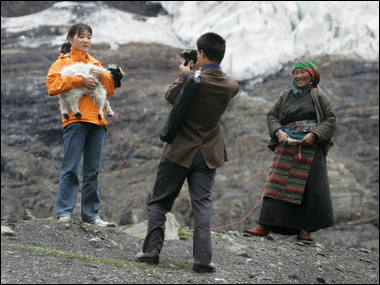Global warming is melting glaciers in China's Tibetan
region at a rate of 7.0 percent annually, triggering drought, desertification
and sandstorms in other regions, state press reported.

Tourists take pictures at the Komolo Glacier
in Tibet. Global warming is melting glaciers in China's Tibetan region at
a rate of 7.0 percent annually, triggering drought, desertification and
sandstorms in other regions. [AFP] |
Data collected over four decades has shown that glaciers on the Qinghai-Tibet
plateau, known as the "roof of the world," are shrinking at an unprecedented
pace, Xinhua news agency said.
"The melting glacier will ultimately trigger more droughts, expand
desertification and increase sandstorms," the report quoted Dong Guangrong, a
specialist at the China Academy of Sciences, as saying.
About 47 percent of China's glaciers are on the Qinghai-Tibet plateau in the
Himalayas, where the Yangtze, Yellow, Brahmaputra, Mekong and Salween rivers all
originate.
The fast rate of glacier melt has meant more water run-off from the plateau
which exacerbates soil erosion and leads to desertification, it said.
Northern China, including Beijing, has suffered from 13 dust storms this year
which have been attributed to desertification in China's northwestern regions,
including Qinghai province.
In the worst storm on April 17, an estimated 336,000 tons of dust fell on
Beijing, leaving the air quality in the capital at hazardous levels.
Rising temperatures on the plateau may also pose a threat to the world's
highest railway, which is expected to go into operation in July, according to
Chinese press reports.
The landmark 26.2 billion yuan (3.16 billion dollar) Tibetan railway linking
Qinghai province with Tibet could be destabilized if the permafrost, or frozen
ground, underneath the tracks melt, the reports said.